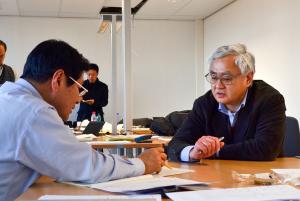Award for ITER Japan's Hideo Nakajima
Hideo Nakajima, a senior engineer at ITER Japan, has received an award from the Japan Society of Mechanical Engineers (JSME) for his contribution to the development of codes and standards for fusion facilities.
The JSME Codes and Standards Award for International Achievement recognizes outstanding contributions to international exchange, the improvement of international codes and standards, and the development of standardization activities in Japan. The ultimate goal of JSME's codes and standards activity is to establish a construction code for a future fusion facility.
A code consists of general requirements and rules for materials, design, fabrication, nondestructive examination, pressure and leak testing, etc. The development of a construction code for ITER, which would define the codes and standards that would ensure the safety and structural integrity of ITER components, started in Japan even before the site selection process was concluded.
In July 2002, a Subcommittee on Fusion Reactors was established under JSME's Main Committee on Power Generation Facility Codes, and work began on the development of rules for the vacuum vessel. Once the Procurement Arrangement for toroidal field magnet structures was signed in 2008 between ITER Japan and the ITER Organization, the group turned to the development of rules for superconducting magnet structures, editing the first Japanese and English editions in 2008 followed by revisions in 2013 and 2017.
With 30 years of experience in the development and evaluation of cryogenic structural materials, Hideo Nakajima's contribution to material standards—which designated design yield and tensile strengths from room temperature to liquid helium temperature (4K) of JJ1 and 316LN steels used in the coil cases—was invaluable.
Mr Nakajima also contributed to the development of the Japanese Industrial Standards (JIS) on testing methods in liquid helium for tensile, elastic-plastic fracture toughness, and fatigue tests of structural materials. Notably, a draft standard of the tensile test was developed in collaboration with the US National Bureau of Standards (currently, the National Institute of Standards and Technology). It was finally published as JIS in Japan, and the American Society for Testing and Materials (ASTM) standard in the United States, respectively. Data measured by ITER Japan according to these standards were also provided to ITER for the design of the ITER magnet system.
The March 2021 award from the Japan Society of Mechanical Engineers specifically recognizes Mr Nakajima's career contributions to "Codes for Fusion Facilities/Rules on Superconducting Magnet Structures." He received a commendation certificate and award plaque on 23 March 2021.


